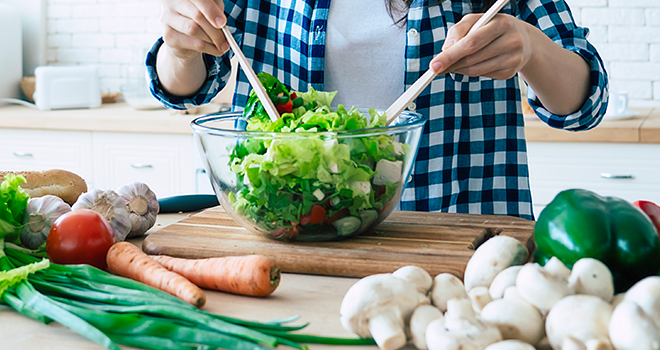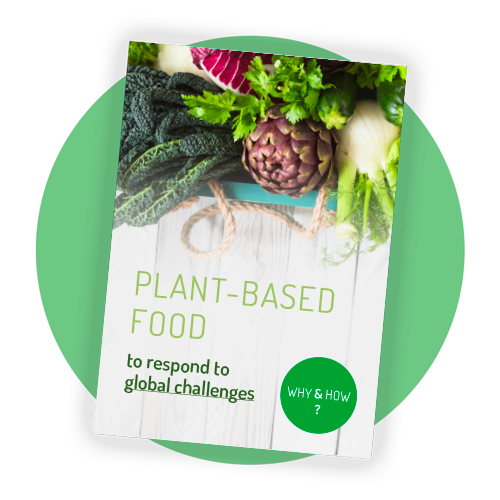Sustainable food is a global challenge, but it is also within everyone’s reach! With some common sense and a few more plant-based foods on your plate, you can boost your health and protect the environment at the same time. It’s easy and fun! To find out what you can do on a daily basis and how you can make the best choices, follow our handy tips.
There’s no denying it… Humanity is facing challenges that call for human health and the health of the planet to be seen as two sides of the same coin. We are all well aware of what we need to do:
- produce food sustainably to support global population growth and slow down global warming
- reduce food waste
- provide everyone with access to healthy food to maintain health
Our current food systems (agriculture, livestock, fisheries, and industrial production) have the potential to support the health of both humans and the planet. But today, they are both under threat (see image 1).
Image 1 – Adapting food systems is essential for sustainable development(1)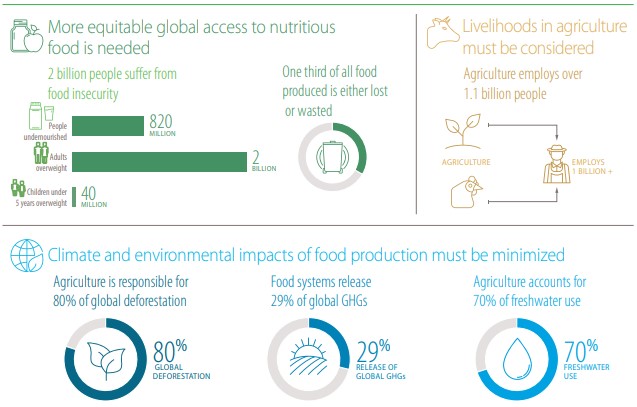
Indeed, there are significant imbalances to be addressed. On the one hand, more than 800 million people do not have access to sufficient food. On the other, almost 2 billion people across the globe are overweight and consume too much food of poor nutritional quality. These excesses deplete key natural resources and generate a lot of waste, which weakens the entire global ecosystem. The consequences are known to us all: greenhouse gas emissions, scarcity of resources, deforestation and… climate change
We can turn things around if we start playing an active role in our food supply
One of the first issues to be addressed is collective. We need to rethink our production systems and make the transition to a more plant-based and sustainable diet.
Currently, the global agricultural system overproduces grains, fats and sugars, while the production of fruits, vegetables and proteins is insufficient to meet the nutritional needs of the entire population (see image 2).
Image 2 – Global production versus recommended consumption(3)
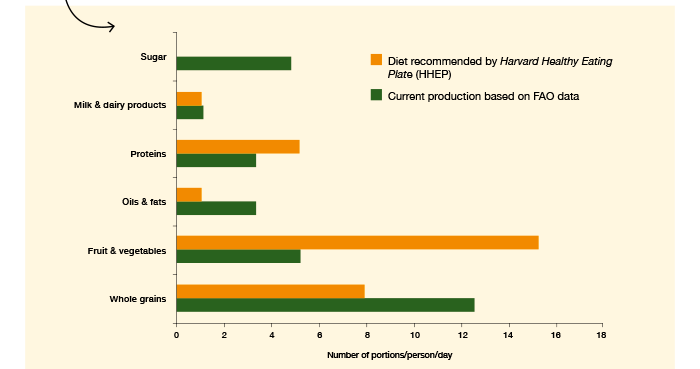
The other challenge is both collective and individual: to break the vicious circle of overconsumption. Consuming more calories than necessary generates more greenhouse gases (GHGs).
Overconsumption of food often leads to a more sedentary lifestyle, which, in turn, results in greater use of transport, a major contributor to GHG emissions. These emissions negatively affect the environment, which increases food insecurity and reduces access to basic commodities, such as fish or fruit and vegetables, by also increasing their cost. This in turn makes it more profitable to produce processed foods of lower nutritional quality…
But things don’t have to be this way. Small changes to our daily lives can soon make a difference, because all these little efforts add up to make a big change!
A more plant-based diet: an easy first step
If you’re looking to make your diet more sustainable, the first thing to do is to eat more plant-based foods. And the good news is that we are on the right track!
The consumption of plant-based foods is on the increase all over the world, and more and more people are becoming flexitarians, particularly inspired by the habits of the new generations and a collective awareness (see image 3). Moreover, the availability of plant-based foods has increased and diversified very quickly, which offers a great advantage: the freedom to CHOOSE.
However, we have not yet reached the recommended consumption levels, especially for fruit and vegetables.
Figure 3 – The consumption of fruit and vegetables is increasing but remains below the recommendations(3)
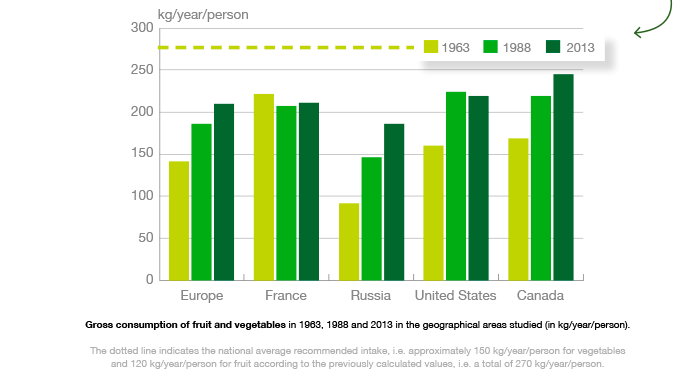
What is the benefit of this shift to a more plant-based diet for you and the population as a whole? Recent scientific studies show that a vegetable-based diet is THE ULTIMATE SOLUTION to feeding people while respecting nature. The benefits can be measured in terms of managing and maintaining land and oceans, controlling GHG emissions, and meeting the nutritional needs of the global population, which is expected to approach 10 billion people by 2050. A plant-based diet also has socio-economic benefits, as it is more resilient.
On an individual level, eating more plant-based foods (fruits, vegetables, legumes, seeds and nuts, and whole grains) also increases the number of healthy life years. The more plant-based foods you consume, the more you reduce the dietary risk of being affected by a number of diseases during your lifetime (obesity, type-2 diabetes, high blood pressure, cancer and so on). This is an observation made across the globe (see image 4).
Figure 4 – Image 4 – Top-10 dietary risk factors(4)
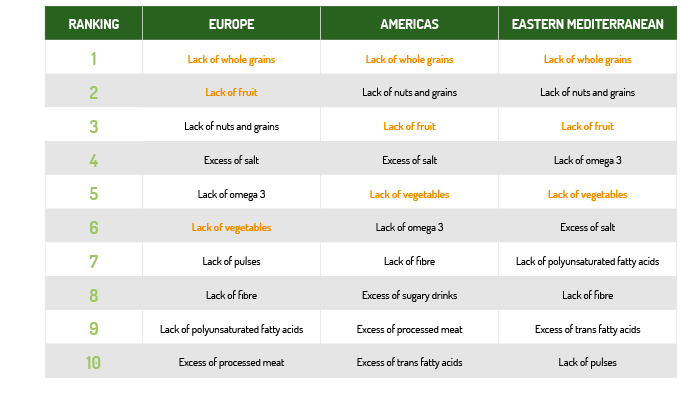
A sustainable diet: instructions for use
Adopting a more sustainable diet means more than just eating five fruits and vegetables a day, of course, or depriving yourself of red meat. The Food and Agriculture Organization of the United Nations (FAO) gives a broader definition of a sustainable diet(4):
“Sustainable diets are diets with low environmental impact that contribute to food and nutrition security and a healthy life for present and future generations. Sustainable diets contribute to protecting and respecting biodiversity and ecosystems, are culturally acceptable, economically equitable and accessible, affordable, nutritionally safe and healthy, and optimise natural and human resources.”
In other words, a sustainable diet should meet the following criteria(3):
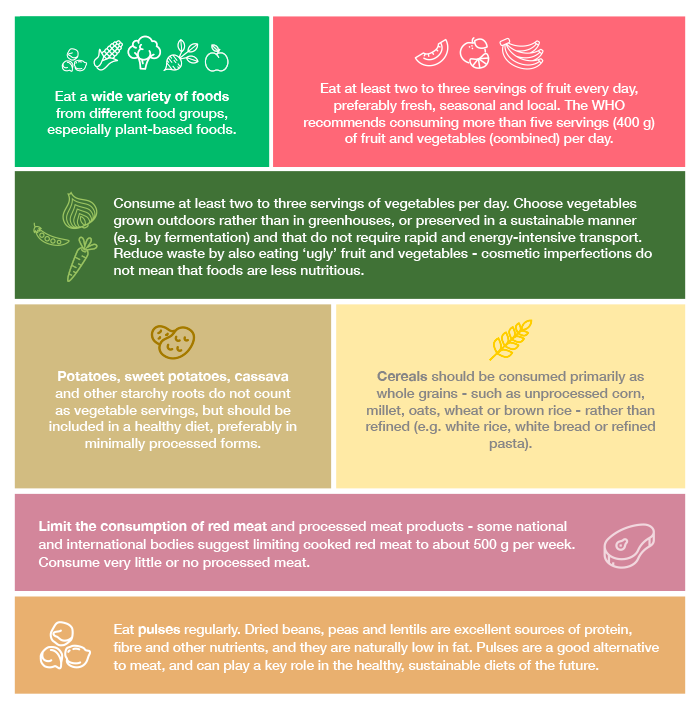
What does the ideal plate look like?
Scientists set out to find an answer to this question in 2019. The EAT-Lancet Commission focused on this debate for 3 years (2), and finally came up with an ideal ‘plate’ on which nutrition and sustainability go hand in hand (see image 5).
This ideal plate includes a large and varied plant-based component (whole grains, fruit and vegetables, legumes and nuts together account for almost 850 g per day). The EAT-Lancet plate contains relatively few animal products, but it is not exclusively plant-based. It favours unsaturated fats over saturated fats, and limits the amount of refined grains, highly processed foods and added sugars. Above all, it is a simple, visual way to put together your meals!
Image 5 – The ideal plate (2)
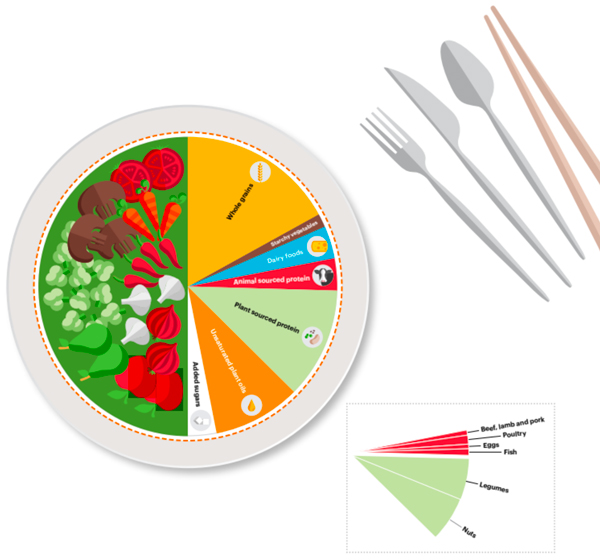



 Bean sprouts
Bean sprouts  Tomato
Tomato  Vegetable garden: growing black radish
Vegetable garden: growing black radish 









